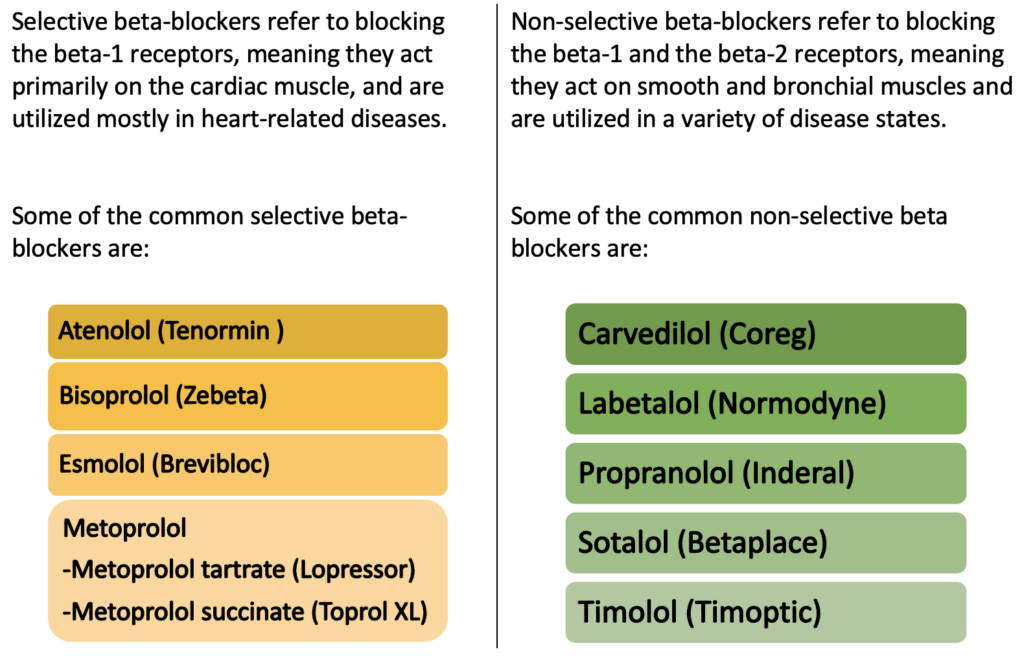
There are roughly 30 million adults on a beta blocker in the United States. Beta-blockers have been around for a very long time. This class of medications has both been used for on and off-label purposes. Over the years, their usage has evolved and has been seen in various disease states. Overall, the indications that this class of medications have been utilized in, are heart failure, glaucoma, hypertension, anxiety, migraines, and many others. This beta blocker refresher will provide you with the overview that will potentially spark your interest to dive deeper into each medication discussed.
Most common beta-blockers have been recognized for being either selective beta blockers or non-selective beta-blockers:

Depending on which specific beta-blocker a patient is prescribed, it is important to provide education on that specific drug’s adverse effects. Individuals taking non-selective beta blockers may experience some side effects that are not seen with selective beta blockers due to their mechanism of action. For example, sotalol has a risk for QT prolongation because it blocks potassium channels. The adverse effects are dependent on the specific drug, but there are overall common side effects seen within this class of medications, such as fatigue, hypotension, dizziness, and bradycardia. The less common side effects that individuals should be aware of are insomnia, weight gain, hepatotoxicity, and bronchospasm. Historically, beta-blockers have been contraindicated in patients with asthma due to their mechanism of action. Also, beta-blockers may mask the signs of hypoglycemia. Patients who have diabetes should be educated on what to do when on a beta blocker just in case they experience hypoglycemia. Beta-blockers, however, have their useful places in therapy. To illustrate, this class of medication has been utilized for its anxiolytic effect. An example is propranolol, which is often prescribed off-label for anxiety or to help with stage performance to reduce some peripheral symptoms associated with anxiety.
Other beta-blocker class pertinent details:
- Individuals should monitor their blood pressure and heart rate while on this medication.
- There are multiple formulations available on the market.
- The most common routes of administration are oral, intravenous, or ophthalmic.
- The dosage of these medications depends on the specific drug.
- Some of these medications come in immediate release or extended release.
- For example, propranolol ranges from 80 mg/day to 320 mg/day, which can be split into multiple doses daily due to its half-life.
- Patients can be on this medication for an extended period of time.
Overall, this class of medication has been on the market for a long time; it is well-established compared to other classes of medications in terms of indications and side effect profiles. It is important to differentiate between selective and non-selective beta-blocker medications to understand their mechanism of action and their respective indications. A large patient population utilizes this class of medications, so it is extra important to keep up with new findings and updates. Hopefully, this refresher on beta-blockers has helped to provide you with beneficial information to continue delivering the best care in your own pharmacy setting.
Dagmara Zajac
RxPharmacist Team
References:
- Beta-blockers: Types, uses and side effects. Cleveland Clinic. https://my.clevelandclinic.org/health/treatments/22318-beta-blockers. Accessed November 28, 2022.
- What you should know about beta blockers. Mayo Clinic. https://www.mayoclinic.org/diseases-conditions/high-blood-pressure/in-depth/beta-blockers/art-20044522. Published August 13, 2021. Accessed November 28, 2022.
- Oliver E, Mayor F Jr, D’Ocon P. Beta-blockers: Historical Perspective and Mechanisms of Action. Rev Esp Cardiol (Engl Ed). 2019;72(10):853-862. doi:10.1016/j.rec.2019.04.006
- LiverTox: Clinical and Research Information on Drug-Induced Liver Injury [Internet]. Bethesda (MD): National Institute of Diabetes and Digestive and Kidney Diseases; 2012-. Beta Adrenergic Blocking Agents. [Updated 2018 Jun 3]. Available from: https://www.ncbi.nlm.nih.gov/books/NBK548127/
- Farzam K, Jan A. Beta Blockers. [Updated 2022 Jul 21]. In: StatPearls [Internet]. Treasure Island (FL): StatPearls Publishing; 2022 Jan-. Available from: https://www.ncbi.nlm.nih.gov/books/NBK532906/
- Srinivasan AV. Propranolol: A 50-Year Historical Perspective. Ann Indian Acad Neurol. 2019;22(1):21-26. doi:10.4103/aian.AIAN_201_18
